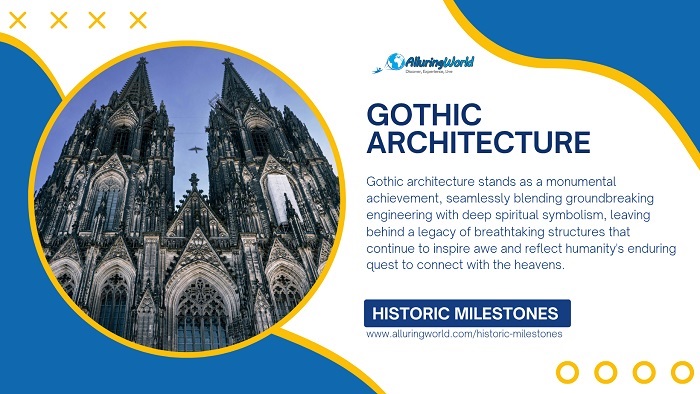Read time ca. 5 minutes
The Gothic architecture which emerged in the 12th century, revolutionized the way buildings were designed, constructed, and experienced at the time, and it is characterized by towering spires, intricate stonework, and awe-inspiring stained glass windows, making this architectural style to simply reflect a desire to reach for the divine. Born out of the medieval Catholic Church’s ambition to create spaces of spiritual grandeur, Gothic cathedrals and churches became symbols of faith, power, and artistic innovation.
Origins and Evolution:
Gothic architecture resulted from a revolutionary departure from the huge, earth-firm Romanesque style, and its origin is traced to 12th-century France. Abbot Suger’s dream reconstruction of the Basilica of Saint-Denis which started in the 1130s, was the crucible in which this novel language of architecture emerged. Through the use of pointed arches, which distributed weight more efficiently, ribbed vaults, allowing for greater spans, and flying buttresses, which directed lateral thrust outward, architects achieved unparalleled heights and interior spaciousness. These innovations enabled the creation of soaring, airy spaces, transforming the experience of religious worship and radically altering the appearance of monumental architecture.
The allure of Gothic architecture soon transcended its French roots, spreading across Europe and prompting the construction of some of the most identified and awe-inspiring cathedrals of all time. Masterpieces like Notre-Dame de Paris, with its elaborate facade and soaring nave, Chartres Cathedral, renowned for its stunning stained glass windows, and Canterbury Cathedral, the very epitome of English ecclesiastical supremacy, continue to stand as witness to the style’s enduring beauty and technical brilliance. These cathedrals, with their stone lace, spires reaching for the sky, and ethereal light, were not just places of worship but also towering icons of civic ego and artistic achievement, an enduring testament which left an indelible mark upon the architectural landscape of Europe.
Innovative Engineering and Design:
The magnificent application of flying buttresses is the hallmark of Gothic engineering. These exterior, arched supports redistributed the weight of the roof and upper walls effectively, releasing architects from the constraints of heavy, load-carrying walls, and this feat of engineering allowed architects to construct thinner walls and massive, expansive windows, bathing interiors in light and transforming them into celestial spaces. This greater structural freedom also allowed the employment of fine tracery and elaborate sculptural ornamentation, further increasing the visual opulence and loveliness of Gothic cathedrals.
In addition to the flying buttress, the ribbed vault was another central element of the Gothic revolution. This architectural feature, characterized by arched ribs that crossed each other and created the ceiling, not only helped to increase structural integrity but also provided an interesting aspect of visual complexity. The contrast of light and dark on the ribbed surfaces created depth and vitality in the interior spaces. All these innovations combined enabled cathedrals to achieve unprecedented heights above the limitations of earlier building styles. That verticality, combined with light plenty and detailed adornment, contributed to the symbolic role of these structures as a physical portal between the earthly realm and heaven, symbolizing spiritual aspirations of the era.
Symbolism and Aesthetic Beauty:
Gothic architecture extended beyond mere structural innovation, imbuing its very form with profound symbolism. The soaring spires and emphasized verticality were deliberately designed to draw the eye upwards towards the heavens, instilling a feeling of awe and inviting the worshipers to raise their minds towards the divine, and this verticality symbolically articulated the aspiration to bridge the gulf between heaven and earth, to create a space for the practice of spiritual contemplation. The stained glass windows, artworks and craft, were the focal points for this symbolic language, and casting sunbeams through resplendent colors and precise renditions of biblical tales and saintly personages, these windows filled the interior spaces with heavenly realms of color and light, an immersive and transfiguring spiritual experience.
Moreover, the sculpted gargoyles, grotesques, and richly ornamented facades that completed Gothic cathedrals served aesthetic purposes beyond their utilitarian purposes as rainwater spouts. They conveyed rich religious and mythological messages while carrying out their functional purpose of delivering rainwater spouts, often depicting symbolic animals and narratives to reinforce the religious and moral teachings of the church. This union of art and purpose, together with the architectural grandeur, created environments that not only were aesthetically stunning but were also deeply charged with symbolic meanings, reflecting the rich religious and cultural beliefs of the days.
Legacy and Revival:
Despite its gradual decline in the late 16th century, as Renaissance architecture came into vogue, the Gothic style experienced a robust comeback in the 19th century, particularly in England and France. The Gothic Revival movement, spearheaded by visionary architects like Augustus Pugin and Eugène Viollet-le-Duc, endeavored to recapture the medieval artisanship’s essence and reinterpret the style afresh. This revival was not a backward imitation; it was a deliberate endeavor to draw on the perceived moral and religious values of medieval times, often looked upon as an antithesis to the industrialization of the time.
The lasting legacy of Gothic architecture extends far past ancient monuments, seeping into contemporary architectural style. Cathedrals, universities, and even skyscrapers in the present day often incorporate elements of its dramatic verticality and ornamentation. The soaring lines, intricate tracery, and illumination continue to serve as an inspiration for architects creating spaces that inspire awe and religious identification. This lasting legacy attests to the ongoing appeal of Gothic architecture, proof that it has had the strength to survive its epoch and remain an engaging force in promoting architectural invention.
Conclusion:
Overall, Gothic architecture stands as one of the most extraordinary artistic and engineering achievements in history. Its ability to combine structural innovation with profound spiritual symbolism allowed it to leave a lasting mark on the landscapes of Europe and beyond, and even centuries later, these awe-inspiring cathedrals and structures continue to captivate, serving as a testament to humanity’s ambition to reach for the heavens.

